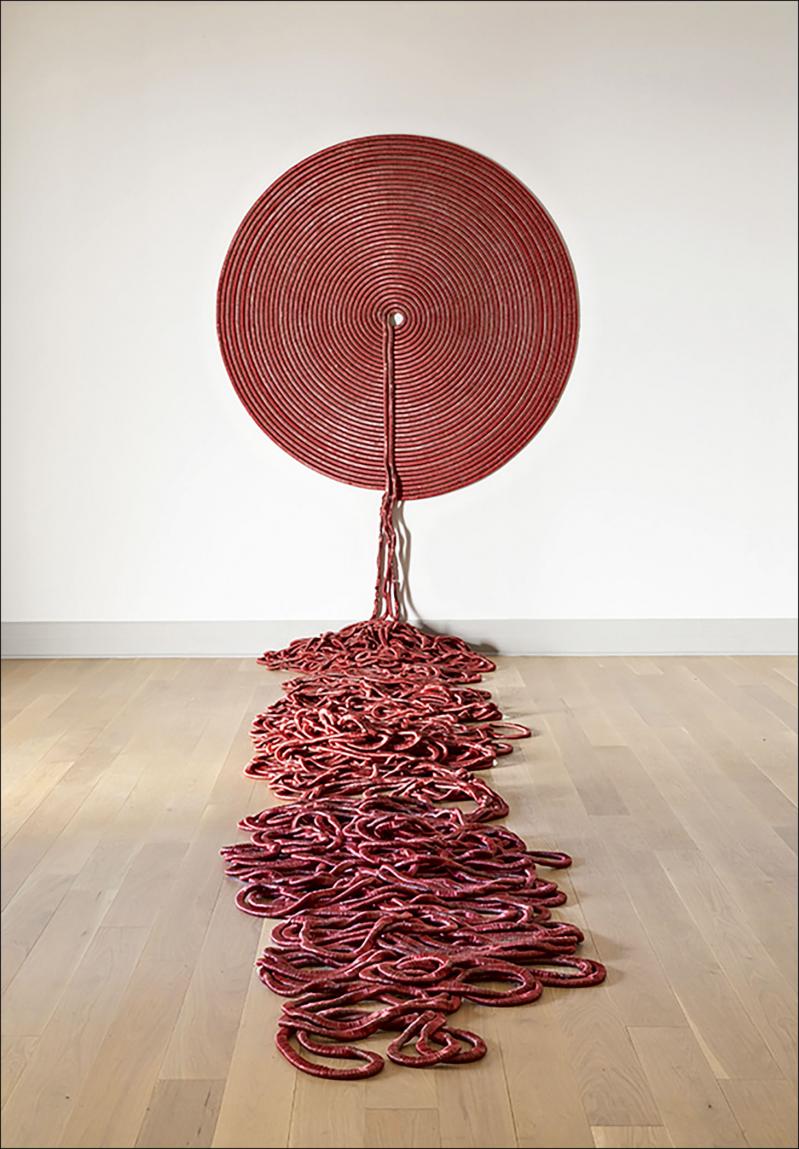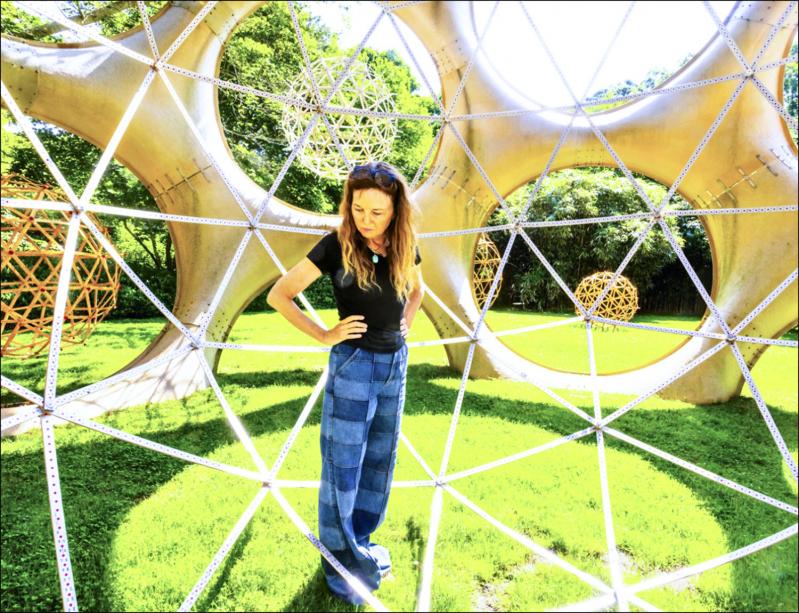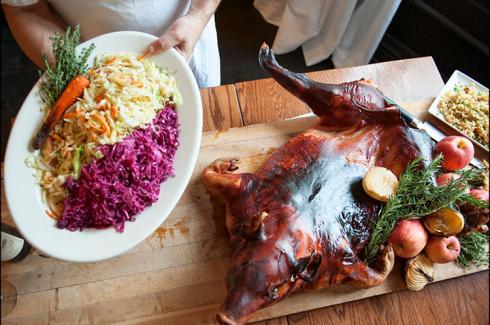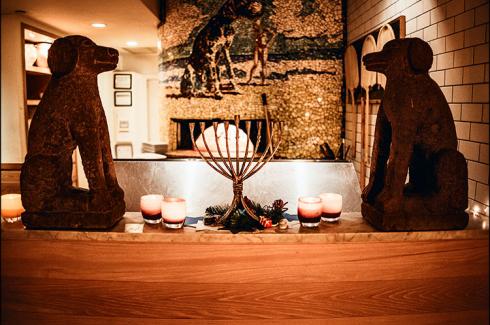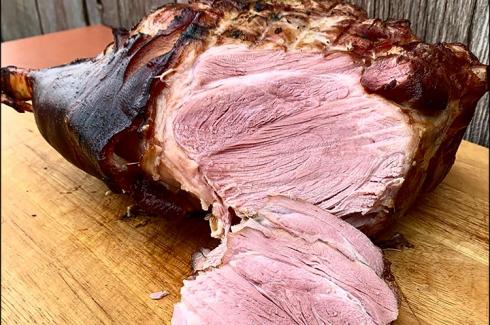Buckminster Fuller’s “Fly’s Eye Dome,” designed by the artist in 1965, was inspired by the eye of a fly. A fiberglass geodesic 33-foot version was produced in 1997 by John Kuthik and initially loaned to LongHouse Reserve by Fuller’s daughter. Over the almost three decades since, it has become one of the venue’s landmark structures, hard to miss as one follows the path from the entrance to the gardens.
Visitors might do a double take this summer, as the dome has company, both inside and around it, thanks to “True Value,” a very site-specific installation by Alice Hope consisting of nine geodesic spheres of varying sizes. The name of the installation derives from the fact that each sphere is made of sections of yardsticks bearing the brand name of the hardware chain. Those sections are attached so that each sphere consists of many triangular sections.
Ms. Hope has been visiting LongHouse since she moved to East Hampton from Oregon in the early ‘90s. “I so cherish the place,” she said during a chat on a rainy day there, “and I saw the evolution and growth and the art that’s been here over time. Dianne Benson [the venue’s president emerita] urged me to do a site-specific work here.”
On a number of winter walk-throughs, hoping to come up with an idea, as soon as she saw the “Fly’s Eye Dome” she knew she wanted to make something in conversation with it. “I immediately decided I didn’t want to make domes. I wanted to make spheres.” Easier said than done.
“I had to teach myself that. There’s so much math to it. And it was a lot of trial and error.” She pointed to the one dome installed on a terrace of the venue’s main house as part of the summer benefit auction. “This one has 270 rulers, cut to three different lengths.” For all of them she settled on a three-frequency, or 3v geodesic sphere.
While Ms. Hope has never used yardsticks or rulers before, she has created many sculptures and site-specific installations using commonplace, often industrial or functional materials, among them vast quantities of magnets and can tabs, conjoined in repetitive structures.
Ms. Hope was born in Hong Kong, where her father managed the Asian section of Merrill Lynch. She lived there for 10 years until, in 1976, the family moved to Oak Ridge, Tenn. “It was the sister town of Los Alamos. It was built as part of the Manhattan Project, so it was this combination of being really Appalachian and rural but also secretive.”
While her mother was an artist, Ms. Hope didn’t start making art until she was at Reed College in Portland, Ore., where she found a lot of leeway as an art major. Even then, in the ‘80s, her work was material-based. “One of the first projects I made was a coat I got from the Salvation Army that I covered completely in buttons. You could see the beginnings there, the repetition.” And the ordinary material.
While at Reed, she met Erling Hope, the son of Leif and Judith Hope of East Hampton. They married after graduating in 1989 and moved to Oregon’s coastal range, where they bought a general store. “Our romantic ideal was to have a gallery in the middle of nowhere and make art. But there was really no audience.”
After she became pregnant with her daughter, Soren, the couple moved to East Hampton. When Soren was 3, they moved again, this time to New Haven, where Ms. Hope entered the M.F.A. program at Yale. (Soren is now enrolled in the same M.F.A. program and will have a show of her paintings in New York City in September.)
After Ms. Hope graduated, the family returned to East Hampton, and she got a job teaching at the Hayground School in Bridgehampton. She and her husband separated, and when Soren was in seventh grade she and her mother moved to New York.
While she made art throughout the years of her daughter’s upbringing, “it never got past my studio. It wasn’t until maybe 2010 that I really started participating in the art world,” although she had a solo show at the Islip Art Museum in 2007, and solo and group shows followed in quick succession.
By 2011, when she was chosen by Agathe Snow for “Artists Choose Artists” at the Parrish Art Museum, she was working with magnets and iron filings, all of which were held together by magnetism. Concurrently she began to work with ball chain, resulting in wall-size conglomerations also held together by magnetism. In a video made at that time she explained that the magnets create the composition. “I don’t intend to make pictorial reference.”
Magnetism appeared on a massive scale for her Parrish Road Show project in 2012 at Camp Hero in Montauk. Beneath the decommissioned radar tower there she covered a 3,400-square-foot area with magnets and steel plates. She selected the site for its electromagnetic history and its obsolescent military architecture. Built in 1960, the radar tower was part of an early warning system.
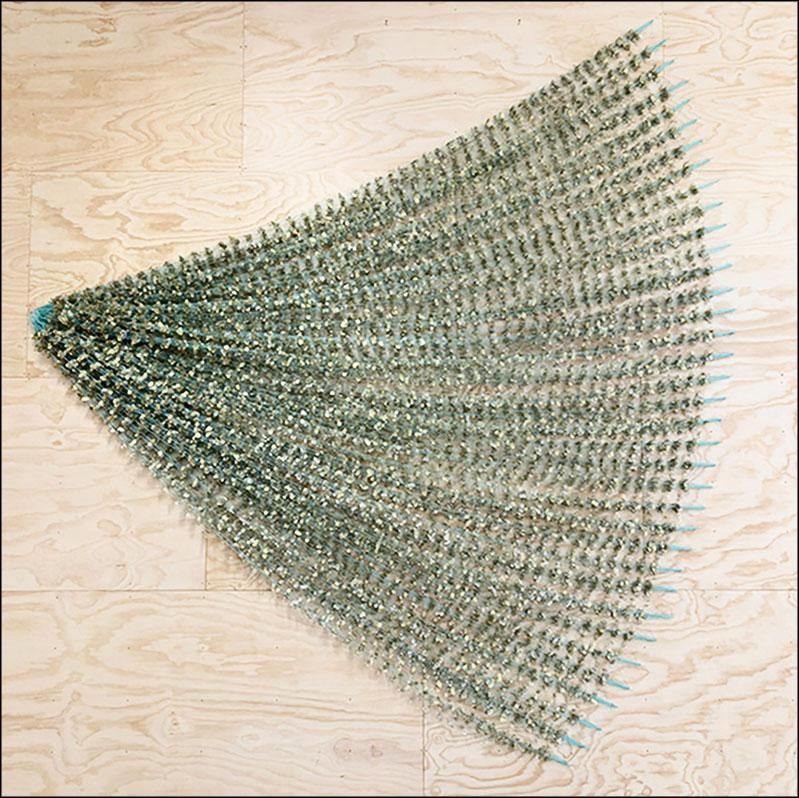
“Andrea Grover and I talked a bit about the Manhattan Project and Oak Ridge,” Ms. Hope said. “It was a little like ‘True Value’ in that what I’m relating to is just so big. Like that radar. The hubris to think I could make an installation in dialogue with that, and it’s the same here at LongHouse.”
About the can tabs that have figured in so much of her work, during an art residency in Utica she had a tour of the recycling center. “There was a big cardboard box full of can tabs that were about to be recycled. I had to make the impulse decision to buy it,” and she did. “I knew immediately the problem was going to be how to attach them. That is the thread throughout, the problem of attachment.”
One solution has been threading them with IV tubing, by which the piece becomes more whole “and people can experience the art without knowing the material,” because the tabs are so close together.
A different kind of attachment arose when she was in Maputo, Mozambique, for an Art in Embassies commission to be installed at the United States Embassy. That project took several years from start to finish. “I got to go over for a site visit, because they wanted the project to be relevant, and in conversation with the art being made there.”
That was where her use of seine nets as a substrate for the can tabs started. “The embassy is on the Indian Ocean, and across from the embassy were fishermen walking back and forth with their seine nets. It was quite melodic, but the piles of seine nets on the beach and the accumulation of it is a big ecological problem.”
“With the economy of means I allow myself two materials, and in that case the materials were seine nets and then hundreds of thousands of can tabs. Each had to be attached individually.” Speaking of the composition of the piece, which rolls in wave-like forms across a long wall, she said, “I almost feel like a conduit and I like the materials to almost seem like they’re starting to reproduce themselves, and then they form the aggregate. That’s when I feel like it goes over the waterfall and has sort of a decorativeness that repetition can give.”
On her website are photographs of her storage space in Bridgehampton, which is filled with can tabs. “I’m waiting for the perfect well-lit room, like the Walter De Maria earth room in SoHo. Filling the space would take on the quality of the dunes and the gravity of it. Even in the storage unit it has a presence, for sure.”
She said that True Value as a brand has a lot of resonance, “up there along with Coca-Cola and Budweiser as an American business.” In a statement about the LongHouse installation, she wrote, “Branded True Value the yardsticks evoke not only standardization and quantification, but also a distinctly American intersection of commerce, labor, advertisement, and the illusion of objective worth.”
She added that red dots punctuate the yardsticks across the surface of the spheres. “In the art world, the red dot signifies a sale, a transaction, a marker of value assigned. In other contexts, it connotes targeting, surveillance, urgency, or erasure. Here, the dots serve as both pattern and code — suggesting the friction between commodification and perception, between utility and symbolism.”
The installation will remain on view through the fall.
